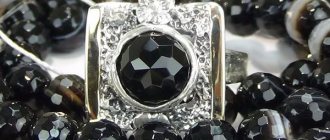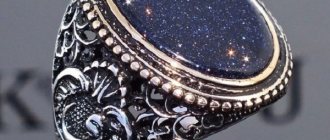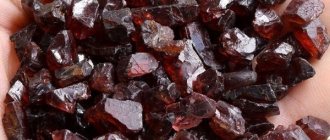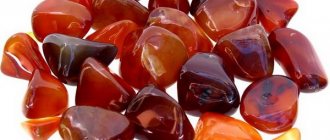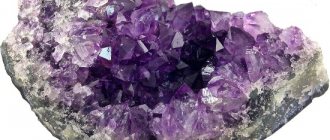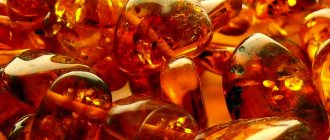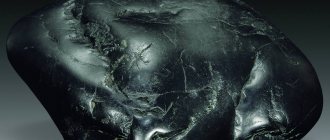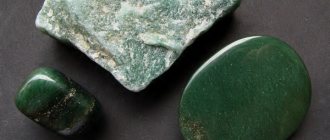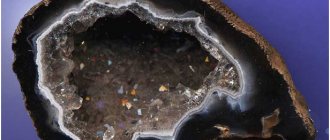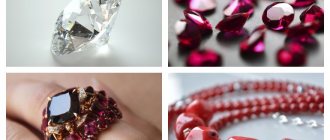The chrysocolla stone, which has many synonymous names (it is called copper malachite, golden glue, green spar and psilomelane), is an obligatory companion of any copper deposit.
Being a mineral of the water element and symbolizing the maternal and feminine principles, the gem magically transforms every representative of the fair sex who owns it.
A polished chrysocolla ball is strikingly similar to a miniature globe - a three-dimensional model of our planet: blue and green stains on the surface of the stone form a pattern reminiscent of the contours of oceans and continents.
You can look at the play of its colors endlessly: this activity is mesmerizing.
What is this stone?
Photo:
Chrysocolla, a silicate mineral, is a hydrous silicate of copper, which gives the stone a bluish-green or bright blue color.
Chrysocolla in the form of dense cluster-shaped aggregates is found in the upper layers of copper veins in mines scattered across different parts of the globe.
The appearance and chemical composition of the mineral - depending on the amount of impurities and impurities - is extremely variable.
For this reason, chrysocolla is often confused with other minerals of similar colors, mistaking it for blue chalcedony, variscite and turquoise.
Deposits and production
Experts identify the most valuable varieties of the mineral that are of Peruvian, Mexican, and Arizona origin. However, in copper mines around the world, the top layers almost always contain chrysocolla. The composition and appearance of the rock differs significantly given the different types of impurities present.
The rock consists of dense cluster-shaped aggregates or thin layers over malachite. Mining is carried out in our country (Mednorudyanskoye deposit, Turinsky mines), Israel, USA, Australia, Kazakhstan, Congo, Chile.
Note! Chrysocolla is often confused with deposits of blue chalcedony, turquoise, and variscite; such minerals are difficult to distinguish externally.
Usage history
The ancient Greek naturalist and philosopher Theophrastus, who lived in the 4th century. dn. BC, discovered copper in the composition of the mineral and invented a method for melting it, which made it possible to use the gem as copper solder in the manufacture of gold jewelry.
He named the mineral chrysocolla (or “golden glue”, translated from ancient Greek).
The discoverers of this beautiful gem were the inhabitants of ancient Egypt.
They actively used stone in various areas of their lives:
- The mineral, ground into powder and mixed with olive oil , was used as eye shadow by both women and men. This natural cosmetic product not only emphasized the beauty of the eyes, but also prevented premature aging of the skin.
- The same powder, mixed with water , was used to produce surprisingly bright and durable mineral paints (green, blue and dark blue), which were used to paint dishes and walls of burial chambers in the pyramids of the pharaohs, and to perform palace paintings and temple frescoes. Drawings made with chrysocolla paints have not lost their brightness to this day.
- Chrysocolla, along with lapis lazuli and malachite, was used as raw material in copper smelting.
- with chrysocolla slabs , and from their fragments they created wonderful mosaic panels.
- The beautiful stone was used to make jewelry , which, in particular, was owned by Cleopatra herself.
According to legend, it was chrysocolla that made the Jewish king Solomon fabulously rich. Its famous mines, mentioned in the Bible, were located in the vicinity of the city of Eilat, located on the shores of the Red Sea.
The extraction and sale of “Eilat” stone, highly valued by residents of countries neighboring Judea, significantly enriched the state treasury.
By order of the legendary king, the floors and walls of the first Jerusalem temple were decorated with chrysocolla slabs.
Legend has it that Solomon never parted with a ring decorated with a magnificent chrysocolla, which endowed him with boundless wisdom.
Paying tribute to the legend, chrysocolla began to be called the stone of King Solomon. (This is interesting: there is also a Pentacle of Solomon).
During the Renaissance, mineral paints made from chrysocolla were used by artists and icon painters.
Storage and care
Despite the fact that when making jewelry, figurines and other items, varieties of strong chrysocolla are selected, the products must be properly cared for:
- protect from sudden temperature changes;
- avoid prolonged contact with water and any other liquid;
- When cleaning, do not use chemicals, acid, or alkali; such cleaning leads to clouding.
To prevent storage from scratching the surface, store items wrapped in cloth, away from other decorations.
Meaning
Today, chrysocolla is most often used as:
- Jewelry and ornamental stone , ideal for making jewelry (pendants, earrings, bracelets, beads and rings), magical items (talismans, amulets and amulets);
- Small plastics (all kinds of figures, figurines and balls).
A malleable mineral that lends itself well to polishing, with proper care it remains smooth and shiny for a long time, and the variety of colors allows it to be set in gold, silver and costume jewelry alloys.
Rare varieties of the mineral, similar to turquoise and valued no less than precious stones, are of particular importance to collectors who replenish their collections with untreated specimens, cabochons or tumbling.
Physical properties
The mineral is characterized by:
- Small (within 2.0-2.2) specific gravity.
- Density equal to 2.1 g/cm3.
- Instability of optical data due to the opacity of the stone.
- Lack of luminescence, dispersion and birefringence.
- Inability to interpret the absorption spectrum.
- Weak pleochroism.
- Hardness, which - depending on the characteristics of the chemical composition - can range from 2-4 points on the Mohs scale (for example, a sample containing silica particles can scratch glass).
- Conchoidal fracture.
- Rhombic system.
- Lack of cleavage.
- Glassy, greasy or waxy sheen.
- A rich range of colors, the diversity of which is due to the presence of impurities. The copper content colors the stone in turquoise tones. The combination of iron, aluminum and copper gives the mineral a golden color, and the tandem of aluminum and iron gives it a green color. Impurities of kaolinite color chrysocolla in sky-blue tones, and the high content of manganese makes its color brown.
The physical properties and chemical composition of chrysocolla are variable, since under the influence of environmental factors the percentage of its main components periodically changes (in some cases quite significantly).
Depending on this, the density, color and even structure of the mineral may change.
Chrysocolla specimens can be dense and hard or brittle and soft. Dense aggregates have a waxy, glassy luster, which gradually disappears as the mineral softens.
Place of Birth
The mineral that forms in copper strata and is mined along with it is not rare. Its rich deposits are found on all continents of our planet.
Chrysocolla mining is established in:
- North and South America (gemologists accurately divide chrysocolla into Peruvian, Mexican and Arizona);
- Europe (Czech Republic and Germany);
- Australia;
- Africa (in Congo and Zaire);
- Kazakhstan;
- Israel.
Chrysocolla vein
In Russia, there are deposits of chrysocolla in Transbaikalia, Altai and the Urals. The Mednorudyanka quarry, located almost in the center of Nizhny Tagil, claims - along with the Arizona quarry - to be the largest chrysocolla deposit.
At the Mednorudyansky quarry and in the Turinsky mines, located in the vicinity of Krasnoturinsk (Sverdlovsk region), demidovite is mined - the most expensive variety of chrysocolla, colored sky blue.
When extracting chrysocolla, which begins to crumble and lose its decorative effect when exposed to high pressure or sudden temperature changes, it is recommended to be very careful.
It is the difficulties that complicate the extraction of semi-precious stone that are the reason for its rather high cost.
Varieties
The color, transparency and luster of different varieties of chrysocolla differ radically.
The chemical composition of crystals is so diverse that it allows gemologists to identify at least a dozen varieties of the mineral, but we will talk in more detail about several main ones.
Asperolite
An opaque mineral, colored greenish-blue, with many black and white specks.
The high water content gives it extraordinary fragility.
The presence of a characteristic oily sheen, a clear pattern and a relatively smooth surface are among the distinctive features of asperolite.
Biisbit
The mineral is pale blue or dark blue in color, endowed with a ribbed structure that can be easily processed (jewelers and stone cutters love it for this quality) and decorated with patterns in green, brown, white, red and yellow tones.
Due to its minimal water content, bisbit is a very dense and matte variety of chrysocolla, with absolutely no shine.
Demidovit
A brilliant mineral of extraordinary beauty, painted in different shades of sky blue, found in the Northern Urals, bears the name of the Russian entrepreneur A. N. Demidov.
Having a coarse grained structure, this stone, formed as a result of the adhesion of bluish-green crusts of chrysocolla to blocks of malachite, is its strongest, densest and most expensive variety.
Collectors classify individual translucent specimens of demidovite as precious stones.
The similarity of demidovite with turquoise is the reason for its high demand among jewelers around the world.
Copper glaze (azurite)
A mixture of lapis lazuli and chrysocolla. A fragile blue compound with numerous inclusions. It is formed in the form of crystals and has perfect cleavage.
Eilat stone
Chrysocolla + turquoise + malachite.
Classification
There are five varieties that differ from each other in optical characteristics, shape and structure, depending on the percentage of water and other impurities in the mineral:
- Bisbyite - characterized by a low water content in the composition, the crystals are painted in a bright blue hue and have a shiny surface;
- Chrysocolla Agricola is a mineral called borax. Belongs to the category of chrysocolla - quartz. It has a rich turquoise hue due to the high content of quartz rocks in its composition.
- Asperolite, on the contrary, is saturated with a large amount of liquid, its crystals are colored in emerald or green-blue shades and have a loose sandy structure. In shape they can resemble foamed masses;
- Malachite flint is a rock formed by mixing three components: malachite, chrysocolla and turquoise. The main color is turquoise, but an impressive list of impurities often reveals itself, appearing as brown, black or blue veins throughout the form.
- Demidovite is a dark green-blue mineral that differs from other varieties in that it forms in the form of thin, almost plate-like aggregates.
Chemical composition
Chrysocolla is not officially recognized by the scientific community as an independent mineral. This is explained by the variable structure of the stone, which does not allow it to be fully identified and designated as an independent product. Its variability is due to the constant absorption or loss of liquid, as a result of which complex chemical processes can occur inside the mineral.
Different communities of scientists assign the following states to it:
- Amorphous.
With the presence of Si4O10 in the composition, which is included in the body by layered veins. This state is classified as hydrous silicates.
- Pseudocrystalline (cryptocrystalline).
Its syngony is rhombic, or is still unknown today. This state includes the mineral in the class of framework silicates.
- Monoclinic.
The mineral does not belong to any class; it is identified as a complex mixture of calloidal formations.
The general chemical formula of gold glue in a monoclinic system is (Cu, Al)2H2Si2O5(OH)4.nH2O, where the percentage of chemical elements is as follows:
- Al2O3 – 3.9%;
- CuO – 42.4%;
- SiO2 – 36.7%;
- H2O – 17.1%.
Common impurities: copper, iron, aluminum, manganese.
Physical properties
| Properties | Description |
| Color | from green to bright blue, with some impurities - brown, gray or marshy inclusions |
| Shine | glass, frosted, wax |
| Cleavage | absent |
| Structure | amorphous, pseudocrystalline |
| Fragility | Yes |
| Hardness | 2-2.5 Mohs |
| Transparency | translucent |
| Kink | conchoidal |
| singonia | monoclinic |
| Irisation | No |
Magic properties
The variability of the mineral is often compared with the unpredictability of female nature, and its magic, which has a beneficial effect on the fair sex, is called feminine.
The magical properties of chrysocolla help them:
- Develop maternal instinct (the influence of the stone will make even a convinced supporter of the childfree movement think about the need for motherhood);
- Find a reliable life partner;
- Get rid of all kinds of phobias;
- Find protection from external negativity and unwanted temptations;
- Identify and reveal previously unknown abilities.
Chrysocolla, endowed with the ability to absorb negative energy directed at its owner, plays the role of a lightning rod and does not allow troubles to befall him.
The mineral, considered the favorite stone of King Solomon, makes its owners smarter and more reasonable. A pebble lying in the pocket of a schoolchild or student will help him successfully cope with any educational task.
Gentle magic, feminine magic
The magic of chrysocolla can be called feminine.
The magical properties of chrysocolla will help protect the sleep of a child (and adults) from nightmares. Just place a piece of mineral at the head of the bed.
The magic of the mineral will help a person overcome shyness and communicate with people more easily.
The meaning of amulets in the house is to purify energy and harmonize space. Balls or gem figures are installed in the house.
This mineral is a strong amulet for women. And the energy of the stone is feminine, but both men and children can wear it. Those who feel unprotected in life.
Chrysocolla is ideal for a woman, especially a business woman. It will add tenderness and femininity to the owner.
Chrysocolla pendant
Throughout pregnancy, a decoration with chrysocolla or a talisman will be a talisman for the woman and the expected baby.
A curious property of the gem is to “return dreamers to earth” and help them get out of an impossible illusion.
Think about it: feminists and followers of the currently fashionable “childfree” trend can be advised to wear jewelry with chrysocolla for six months. Maybe she will awaken the eternal feminine in them. We recommend: The meaning and properties of QUARTZ DRUZ
Medicinal properties
The healing properties of chrysocolla allow it to be used to treat:
- Alcohol addiction , however, the help of the stone will be effective only if the person himself wants to get rid of alcoholism. Constantly wearing a bracelet or ring with this stone will help speed up getting a positive result.
- Gynecological problems (inflammation of the female reproductive organs, menstrual irregularities, hormonal imbalances).
- Infertility.
- Diseases of the upper respiratory tract (colds, bronchitis, sore throat, etc.). Beads or a pendant made of chrysocolla will ease the production of sputum, stop attacks of suffocation and speed up the patient’s recovery.
- Chronic diseases of the gastrointestinal tract. Wearing bracelets, beads and rings promotes rapid restoration of the mucous membrane and scarring of gastric ulcers.
- Mental disorders (apathy, depression, sleep disorders).
- Neglected wounds. By rolling a pebble around their edges, you can stop bleeding, speed up the regeneration of affected tissues and slow down inflammatory processes.
- Pain syndrome. A stone applied to the problem area normalizes the patient's condition within 2-3 minutes.
Treatment with chrysocolla
The energy of the stone, as esotericists say, steadily but gently enhances the main thing in a woman - tenderness, caring, kindness. The gem is indispensable for women. It not only helps to heal gynecological diseases.
We recommend: All about the Aventurine stone
Lithotherapists advise wearing:
- beads or pendant for problems with the thyroid gland, throat diseases, colds;
- a bracelet or ring with chrysolite will help relieve pain due to gastrointestinal problems;
- the mineral will help cope with insomnia, stress, and excessive nervous stress.
According to lithotherapists, chrysocolla beads will help cope with coughing attacks and pulmonary ailments.
Ring with chrysocolla
Lithotherapists claim that they weaken dependence on tobacco and reduce the craving for smoking.
A very important property of the gem, according to lithotherapists, is that it helps in getting rid of alcoholism.
It has long been believed that constantly wearing chrysocolla amulets or jewelry helps to get rid of drunkenness. This is based on the property of the mineral to relieve obsessive states.
For men, it would be good to wear a bracelet, cufflinks, and a tie clip with chrysocolla. It is advisable to pick up a gem ball more often.
Chrysocolla is not a panacea. It can help a person who himself wants to get rid of alcoholism.
Secretly sewing a piece of mineral into an alcoholic’s clothes is useless.
The healing properties of the mineral are well manifested in cases of copper deficiency in the body. Symptoms of such a deficiency are osteoporosis, pinpoint hemorrhages, leukopenia, anemia. Wear jewelry so that it touches your skin.
Chrysocolla beads
Lithotherapists apply gemstone plates to sore, inflamed areas. They claim that this procedure helps even with rheumatism.
Important: stones do not replace medicine, but help speed up healing from illnesses.
Who is suitable according to their zodiac sign?
Chrysocolla is one of the minerals that is suitable for representatives of any zodiac sign, however, for Sagittarius and Taurus, compatibility with this stone is maximum.
Who else is it suitable for:
- With chrysocolla, Taurus will gain a sense of security, self-confidence and harmony with the world around them. The influence of the gem will make them more adequate, wise and successful.
- The gem will not only protect Sagittarians from all sorts of misfortunes, but will also teach them to cope with emotions, getting rid of the habit of panicking in emergency situations .
- Having secured the support of the mineral, Cancers and Aquarius will engage in self-development and will be able to realize their rich creative potential, gain wisdom and develop intuition.
- Possession of a stone will fill the lives of Virgos , Leo and Libra with harmony, bringing them happiness and financial well-being.
- The support of chrysocolla will help Gemini strengthen their already remarkable intelligence.
- The magic of chrysocolla will relieve Pisces of indecision, making them more purposeful, collected and disciplined.
- Capricorns, Aries and Scorpios will be able to improve their health with the help of the gem.
Chrysocolla and the signs of the zodiac
There are few stones that suit any zodiac sign. Each mineral reveals hidden abilities and characteristics characteristic of a particular zodiac sign. If you want to gain wisdom and confidence, the right action is to choose chrysocolla, regardless of what zodiac sign you belong to. Each owner of this talisman will begin to understand himself better with it, and it will be easier for him to determine the right path in life.
According to astrological criteria, the nugget belongs to the stones endowed with the energy of Venus and Neptune. Because of this, it is better suited to zodiac signs such as Taurus and Sagittarius. These people, under the influence of the gem, will become much more balanced, they will have a desire to listen to their own intuition, after which they will certainly develop decisiveness when making fateful decisions. Zodiac signs such as Cancer, Leo or Aquarius can also wear the mineral. It interacts perfectly with their internal energy, helping them through life with its properties.
Who is the name suitable for?
Chrysocolla (as a powerful amulet) is suitable:
- Women with names: Sofia, Maria, Galina, Miroslava, Emilia, Karina, Lyubov.
- Men named: Ivan, Mark, Julian, Igor, Matvey, Zakhar, Yuri.
You should give up ownership of this gem:
- Irinam, Annam, Varvaram, Natalia, Ingam, Catherine.
- Arkady, Evgeny, Andrey, Anatoly, Sergey.
Talismans and amulets
Chrysocolla, used as a talisman, is capable of:
- Free your owner from nightmares , excessive anxiety and all kinds of phobias. To enhance the magical effect, it is recommended to wear the gem around your neck. An amulet hung at the head of the crib will protect the baby from sleepwalking, nightmares and fear of the dark.
- Protect the home of its owner from external evil , preventing its penetration through a TV screen or computer monitor. The negative energy of bad people who visit the house will be instantly neutralized and returned to them. Feeling this, they will want to leave immediately and will refrain from returning visits. To protect your home, it is recommended to use small chrysocolla figurines, placing them at the entrance, in the most visible place.
- Ensure the normal course of pregnancy throughout its entire duration.
- Protect the owner from magical influences and the machinations of ill-wishers. Translucent stones of a soft blue color will best cope with this task. They should be worn in plain sight, in the form of a brooch, beads, earrings or pendant.
You should know that if the magical effect is too powerful, chrysocolla can burst, scattering into small particles.
In this case, you should absolutely not repair the damaged jewelry or use its fragments in any way: they can pose a danger. It is best to either throw them away or bury them in a secluded place.
Chrysocolla, playing the role of a talisman, will help:
- Lovers avoid quarrels and conflicts.
- People involved in science should determine the main direction of work and find a quick way to achieve the intended goal (right-handed people should wear a ring with a gem on their right hand, left-handed people should wear it on their left).
- Creative people can find inspiration by finding the right balance between sober calculation and flight of fancy.
- Shy people can discover their leadership or speaking abilities.
In order to enhance the magical properties of chrysocolla, it is recommended to set it in copper.
Decorations
Jewelry with chrysocolla looks equally organic in both everyday and evening looks intended for attending business meetings and social events.
The best metals to frame this gem are platinum and silver.
By protecting the fragile mineral from mechanical damage, they not only emphasize its extraordinary beauty, but also greatly enhance its magical properties.
Origin story
This stone is very mysterious with its extraordinary beauty. He became known long before the beginning of our era. The properties of chrysocolla were first studied by the philosopher Theophrastus, who gave the name to the nugget.
Helpful information
The term implies that the gem is used to solder gold jewelry to it. Since the mineral was previously used as gold ore, the name is entirely appropriate. The first part of the word is translated as gold, the second is glue. Although the former use has become a thing of the past, the name of this mineral has remained.
This stone also received a second name - Elat mineral. It was used for painting wall frescoes and finishing jewelry. Paint of different colors was obtained from this mineral. It is still preserved on the dilapidated walls of pyramids, the surfaces of tombs, and household items of the ancient Egyptians.
Price
The price of products with chrysocolla depends on many factors: the place of extraction of the stone, its color, size, purity and complexity of jewelry processing.
Price:
- A pendant with a natural stone can cost the buyer from 1,500 to 32,000 rubles.
- The cost of earrings in a silver frame ranges from 980-6,000 rubles.
- The bracelet can be bought for 720-5,800 rubles.
- The cost of a ring with a chrysocolla insert, depending on the metal of the frame, can range from 1,600 to 145,000 rubles.
- For a mineral processed as a cabochon, a buyer can pay from 300 to 2,500 rubles.
Care
In order for jewelry with chrysocolla to delight its owner for many years, it is recommended:
- Take them off when visiting a sauna , bathhouse and before any water procedures, since this stone is afraid of sudden temperature changes, and exposure to water will only increase its natural fragility over time. Products with gemstones that dissolve in acids must also be removed before cleaning with aggressive detergents.
- Refrain from wearing earrings and rings in frosty weather (beads and pendants can be hidden under clothing), as well as on extremely hot days.
- Do not steam or ultrasonic clean the product.
- Clean a gem that is afraid of water only with a dry brush or a soft cloth made of suede or flannel, avoiding rough and intense impact on the stone.
- Do not expose the mineral to infrared and ultraviolet radiation, so you should not wear jewelry with it when going to the beach or solarium.
- Protect the fragile gem from impacts and falls from heights. It should be stored separately from other stones, in a soft bag made of suede or velvet.
How to distinguish from a fake?
Despite the low cost of chrysocolla, it is sometimes counterfeited. The powder left over from the cutting of jewelry samples is pressed, holding it together using special cements.
Jewelry is made from the resulting briquettes of pressed stone (in principle, it is natural, despite the complete absence of healing and magical properties).
In order to avoid becoming a victim of deception, it is recommended:
- Carefully examine and touch the stone: an excessive number of black specks and a sticky feeling that occurs upon contact with the mineral are signs of a fake.
- Squeeze the pebble in your hand. The temperature of a natural mineral, endowed with low thermal conductivity, will hardly change, while an imitation made of glass or plastic will heat up almost instantly.
- Touch the stone with your tongue. A natural gem containing a large amount of hygroscopic copper silicate will immediately stick to the tongue, and the degree of adhesion will be higher in specimens whose chemical composition contains less water.
- If beads are being checked , touch the thread on which they are strung with your fingers. Blue skin will indicate a fake.
The healing properties of chrysocolla
The studied medicinal properties in the form of a calming effect save owners from nerve disorders: feelings of guilt or anxiety. Chrysocolla is a useful mineral for women, as it reduces the pain of menstruation, helps make pregnancy easier, eliminating anxiety during childbirth.
This stone helps to normalize the functions of the adrenal glands and has a beneficial effect on the thyroid gland. Its medicinal properties are recommended for use in the treatment of laryngitis. The mineral is also useful for surges in blood pressure and increased sugar concentrations, blood pathologies, and lung diseases. It helps improve digestion, eliminates rheumatism, and overcomes pathologies of the hip joints. The nugget strengthens muscles, helps in situations with burns, and alleviates muscle cramps.
The healing properties of the mineral are expressed so extensively because chrysocolla opens the throat chakra. When it is blocked, the functioning of other chakras becomes unbalanced. If the throat chakra is open and in a harmonious, balanced state, a person is able to convey his personal truth to others. The energy rising from the lower chakras is provided by natural release and the ability to express freely.
Thanks to the successful combination of the throat and heart chakras, which chrysocolla provides, its owner calms down, and signs of emotional distress and heart pain are alleviated. Such opportunities open up the ability to feel love fully. It is the heart chakra that clearly regulates the interaction between the internal and external world of an individual; it controls everything that a person perceives or what he resists.
What stones does it go with?
Decoration made of chrysocolla, malachite and labradorite
- Being a mineral of the water element, chrysocolla harmonizes perfectly with Water gems: opal, emerald, moonstone and malachite .
- The proximity to bright gems ( tiger's eye, coral and amber ) helps to enhance the energetic power of chrysocolla.
- The combination of chrysocolla with larimar , lapis lazuli and aquamarine is neutral: the beneficial properties of the minerals, although they do not suffer, are not multiplied.
It is extremely undesirable to combine chrysocolla with pearls: a person who allows such a combination will experience mental discomfort.
Healing capabilities of the stone
In ancient times, people tried to benefit from everything that was available to them. “Stone medicine” was especially popular. That is why rulers: emperors, princes and kings literally hung themselves with various minerals.
Also read: Crocoite is a mineral of shining fiery color
To date, the effect of minerals on the human body has not been fully studied. However, even modern scientists and doctors recognize that the healing properties of stones have enormous potential.
It should be remembered that products made from minerals should not be accepted even from the closest people. The stone senses the human biofield and seems to become part of it. Therefore, chrysocolla jewelry should only have one owner.
- Chrysocolla for women's health . Copper, abundantly contained in this mineral, is responsible for the synthesis of female sex hormones. That is why the copper nugget is rightfully called a female healer. Wearing earrings, rings, and chrysocolla beads will help cope with gynecological problems. It has been noted that a woman who constantly wears jewelry with a copper nugget does not experience the pain of premenstrual syndrome, and her cycle becomes stable and regular. For medicinal purposes, the mineral is well combined with silver and zirconium. Applying an untreated stone to the sore spot has an even more obvious effect. Wearing chrysocolla jewelry during pregnancy will ensure the favorable development of the baby and peace of mind for the expectant mother. This mineral can relieve premature birth, uterine tone and much more.
- Mineral for problems with the thyroid gland . The thyroid gland is a small but very important endocrine organ. It is responsible for thermoregulation, the functioning of the cardiovascular system, metabolism and much more. When thyroid function is impaired, the entire body suffers. Chrysocolla is able to normalize the hormonal levels of the thyroid gland, as well as protect the sensitive organ from the harmful effects of the external environment. Of course, in case of serious diseases of the thyroid gland, one should not forget about modern medicine. Medicines together with the wonderful chrysocolla will restore health for many years.
- Bad habits . This stone can help a person quit drinking cigarettes and alcohol. The mineral improves hormonal levels, restoring the body from the inside, which improves well-being and mood. In this case, the dominant role is played by the psychological mood of the person. Chrysocolla affects the biofield, thereby calming a person and making giving up bad habits easy and painless.
- Wound healing . One of the most beautiful properties of chrysocolla is its ability to restore damaged tissues, accelerating their regeneration and normalizing blood circulation. In order to achieve success, you need to apply the mineral to the damaged area or scar for 15-20 minutes, and then thoroughly wash the area with water. Within a few days a person will notice a significant improvement. Girls who want to discover the secret of eternal youth are recommended to wash their faces with water infused with chrysocolla. This recipe will get rid of itching and redness of the skin, tighten fine wrinkles, and make the skin beautiful and velvety.
- Pain relief . Chrysocolla jewelry has the miraculous ability to relieve pain. People suffering from migraines are advised to keep a pendant with an azure mineral with them. Literally after two or three minutes of application to the place of pain, the unpleasant sensations leave and the state of health returns to normal.
Also read: Corundum is a rare and precious mineral
Interesting Facts
In ancient Egypt, chrysocolla, ground into powder, was sometimes used as a poison, capable of killing a person completely unnoticed due to its extremely slow action.
The toxic effect of the powder is explained by the high content of copper salts, which are extremely dangerous for the human body, in the chemical composition of the mineral.
Nowadays, chrysocolla jewelry inserts are coated with a protective coating to eliminate the risk of accidental poisoning.
Each specimen of chrysocolla is unique. Even in paired products with inserts obtained from the same unit, each pebble will look slightly different.
That is why, when purchasing chrysocolla products, the buyer can rest assured of their absolute uniqueness.
